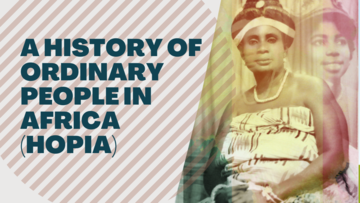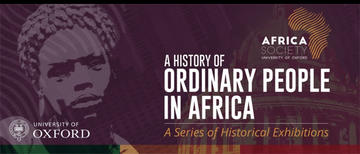Rendezvous With The Ephemeral and The Intangible
Rendezvous With The Ephemeral and The Intangible

A History of Ordinary People in Africa (HOPIA) is a series of historical exhibitions, and a cultural heritage project undertaken by the Oxford University Africa Society in partnership with Fusion Arts Oxford, and funded by TORCH, and the Oxford African Studies Centre. The first project in the series, ‘Pathfinders, Enablers & Matriarchs’, was launched on May 28th and May 29th at St Antony’s College. Approximately 100 people attended that event and other secondary displays.
Exhibitions are by nature ephemeral, whether they last a few minutes or a few months, they invariably have a start and end date. An exhibition may reappear, at another time and in another place, but it never returns the same, just like each staging of a play is unique. It is natural to ask oneself, what is left when the performance ends, the walls are cleared and the artefacts removed? The outcomes of an exhibition are also mostly intangible, made of minuscule and deep interactions that take place between the attendees and the exhibits, and among the attendees themselves. Why is it, then, that we sought to make an exhibition of A History of Ordinary People in Africa? I have had a few weeks to reflect on this and I'd like to share with you the value I found in the ephemeral and in the intangible.
The Idea
The concept of a series of historical exhibitions focusing on ordinary people in Africa, or more precisely, ordinary aspects of life, was born in conversation. It was not one conversation, but many, over time, which I can trace back to the intangible outcomes of previous exhibitions.
One starting point was '200 Days of Lumumba', which took place in February 2020, a multimedia presentation on the last days of Patrice Lumumba, the assassinated prime minister of Congo DRC, whose remains have recently been returned to his family. The event brought to the foreground lesser known aspects of Lumumba's life and death, the original sin at the conception of one of the most embattled countries in Africa today. However, the post-event reflections highlighted how many other lives, achievements, and tragedies might have been forgotten in the shadow of Lumumba.
Another starting point was the 60th anniversary of the Oxford University Africa Society, which took place in June 2018 and whose posters have been exhibited often since then. A key element of the anniversary were seven posters which traced 60 years of the student society alongside multiple threads that intersected with world events. Working on those posters was what made me fall in love with archival research and reading old newspapers. Their black and white pages challenged what I thought I knew about the past and added depth to the events and issues that past members of the Africa Society dealt with. The conversations we had around the posters also revealed what we should always know about archives: they are by nature incomplete. Understanding whose voices are left out is as important as understanding their content.
By the time we printed the last poster for the Hopia-Ghana exhibition, I already had many reasons to be happy. The stories we were going to present would not only reveal lesser known aspects of everyday life in postcolonial Ghana, and expose their interdependence with macro-historical phenomena. They would also put on stage the experiences of ordinary women, whose experiences and contributions are rarely reported, even within modern African historiography. Most importantly, we had taken the first important step towards creating a brand new archive of histories that will light new pathways for future retronauts.
The Stories
The title of the Hopia-Ghana exhibition emerged organically from the histories we collected. We decided where and when to look, but imposed no other limits and had no control over the answers we got. Thus, the title was a recognition of the character of the stories that came back: Pathfinders, Enablers, and Matriarchs.
We found that the building and breaking of relationships were recurring themes. Almost always, the women whose stories are included in the exhibition are matriarchs of large families. This was further accentuated by the fact that the authors of the stories valued those relationship building skills and were directly affected by it.
Migration was also a common trait, by choice or by chance. At times the women only moved within neighbouring villages, other times they crossed national borders, and one has to wonder what they thought of borders that had been in existence for less time than they had been alive. We used a map to keep track of the places of their lives.
For each woman whose story we could tell, we often touched other women whose stories ended prematurely, after giving birth or shortly after. Coping with loss, while establishing a foundation for the next generation, is an integral part of the lives of ordinary women, as much in Ghana as anywhere else in the world.
The Exhibition
To explain the difference between cinema and theatre, a playwright once said: 'Plays happen'. That is, script and direction are only one part of the whole. Actors adapt their timing and interpretation to the reactions of the live audience, unlike in a movie. The audience as well interprets the script and performance as it is happening and immediately after, in ways that are unique to each audience. The ephemeral character of an exhibition is also what makes it happen, in other words what takes the research out of the conceptual realm and establishes it within the physical realm. Things happen only in the real world.
For three weeks between May and June, passerbys in Oxford were surprised by a window, within one of its prestigious city centre walls, into the ordinary and extraordinary experiences of seven Ghanaian women. This was a portal, of some sorts, from Oxford to Accra, Tema, Kumasi, Pepease, Mamfe Akropong, Sefwi Wiawso and other towns and villages they would otherwise never have heard of. For two days, on May 28th and May 29th, the entire Investcorp Gallery, at St. Antony’s College, was transported far away and back in time, to the days and the work of our ancestors. Within walls adorned not only with their histories, but also with their gaze, countless conversations took place and others were scheduled. We spoke of the changing landscapes and cityscapes in Ghana, we discussed the tensions and intermixing of indigenous and imported religions, we compared new and old forms of governance and raised questions about the sophisticated rules of chieftaincy.
The gallery became a vibrant public square, filled with music and newspaper headlines as could be heard and read in the 60s and 80s in Ghana. There, revellers from a range of backgrounds met, in celebration and contemplation. When the square vanished, two days later, it left us with more questions than answers, and this I found most exciting: much work remains to be done.



